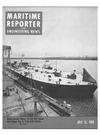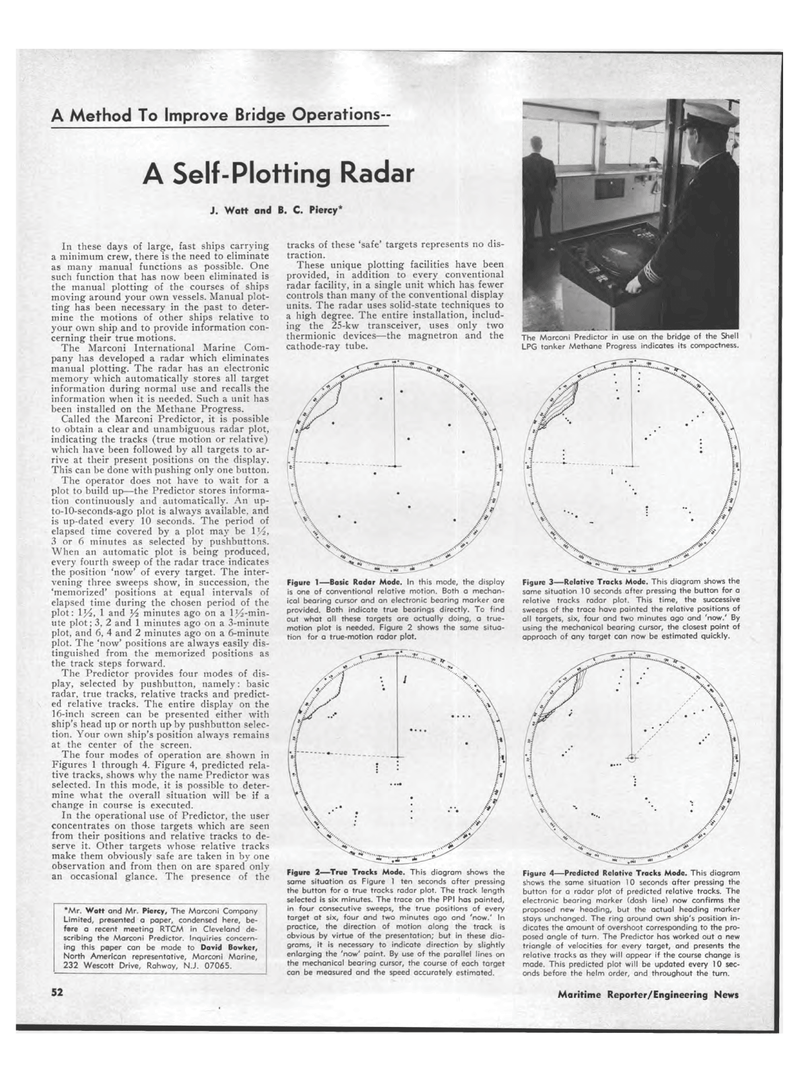
Page 48: of Maritime Reporter Magazine (July 15, 1969)
Read this page in Pdf, Flash or Html5 edition of July 15, 1969 Maritime Reporter Magazine
*Mr. Watt and Mr. Piercy, The Marconi Company Limited, presented a paper, condensed here, be-fore a recent meeting RTCM in Cleveland de-scribing the Marconi Predictor. Inquiries concern-ing this paper can be made to David Bowker, North American representative, Marconi Marine, 232 Wescott Drive, Rahway, N.J. 07065. A Method To Improve Bridge Operations--A Self-Plotting Radar J. Watt and B. C. Piercy* In these days of large, fast ships carrying a minimum crew, there is the need to eliminate as many manual functions as possible. One such function that has now been eliminated is the manual plotting of the courses of ships moving around your own vessels. Manual plot-ting has been necessary in the past to deter-mine the motions of other ships relative to your own ship and to provide information con-cerning their true motions. The Marconi International Marine Com-pany has developed a radar which eliminates manual plotting. The radar has an electronic memory which automatically stores all target information during normal use and recalls the information when it is needed. Such a unit has been installed on the Methane Progress. Called the Marconi Predictor, it is possible to obtain a clear and unambiguous radar plot, indicating the tracks (true motion or relative) which have been followed by all targets to ar-rive at their present positions on the display. This can be done with pushing only one button. The operator does not have to wait for a plot to build up?the Predictor stores informa-tion continuously and automatically. An up-to-10-seconds-ago plot is always available, and is up-dated every 10 seconds. The period of elapsed time covered by a plot may be IV2, 3 or 6 minutes as selected by pushbuttons. When an automatic plot is being produced, every fourth sweep of the radar trace indicates the position 'now' of every target. The inter-vening three sweeps show, in succession, the 'memorized' positions at equal intervals of elapsed time during the chosen period of the plot: 1^2, 1 and Yi minutes ago on a lj^-min-ute plot; 3, 2 and 1 minutes ago on a 3-minute plot, and 6, 4 and 2 minutes ago on a 6-minute plot. The 'now' positions are always easily dis-tinguished from the memorized positions as the track steps forward. The Predictor provides four modes of dis-play, selected by pushbutton, namely: basic radar, true tracks, relative tracks and predict-ed relative tracks. The entire display on the 16-inch screen can be presented either with ship's head up or north up by pushbutton selec-tion. Your own ship's position always remains at the center of the screen. The four modes of operation are shown in Figures 1 through 4. Figure 4, predicted rela-tive tracks, shows why the name Predictor was selected. In this mode, it is possible to deter-mine what the overall situation will be if a change in course is executed. In the operational use of Predictor, the user concentrates on those targets which are seen from their positions and relative tracks to de-serve it. Other targets whose relative tracks make them obviously safe are taken in by one observation and from then on are spared only an occasional glance. The presence of the tracks of these 'safe' targets represents no dis-traction. These unique plotting facilities have been provided, in addition to every conventional radar facility, in a single unit which has fewer controls than many of the conventional display units. The radar uses solid-state techniques to a high degree. The entire installation, includ-ing the 25-kw transceiver, uses only two thermionic devices?the magnetron and the cathode-ray tube. The Marconi Predictor in use on the bridge of the Shell LPG tanker Methane Progress indicates its compactness. Figure 1?Basic Radar Mode. In this mode, the display is one of conventional relative motion. Both a mechan-ical bearing cursor and an electronic bearing marker are provided. Both indicate true bearings directly. To find out what all these targets are actually doing, a true-motion plot is needed. Figure 2 shows the same situa-tion for a true-motion radar plot. Figure 3?Relative Tracks Mode. This diagram shows the same situation 1 0 seconds after pressing the button for a relative tracks radar plot. This time, the successive sweeps of the trace have painted the relative positions of all targets, six, four and two minutes ago and 'now.' By using the mechanical bearing cursor, the closest point of approach of any target can now be estimated quickly. Figure 2?True Tracks Mode. This diagram shows the same situation as Figure 1 ten seconds after pressing the button for a true tracks radar plot. The track length selected is six minutes. The trace on the PPI has painted, in four consecutive sweeps, the true positions of every target at six, four and two minutes ago and 'now.' In practice, the direction of motion along the track is obvious by virtue of the presentation; but in these dia-grams, it is necessary to indicate direction by slightly enlarging the 'now' paint. By use of the parallel lines on the mechanical bearing cursor, the course of each target can be measured and the speed accurately estimated. Figure 4?Predicted Relative Tracks Mode. This diagram shows the same situation 10 seconds after pressing the button for a radar plot of predicted relative tracks. The electronic bearing marker (dash line) now confirms the proposed new heading, but the actual heading marker stays unchanged. The ring around own ship's position in-dicates the amount of overshoot corresponding to the pro-posed angle of turn. The Predictor has worked out a new triangle of velocities for every target, and presents the relative tracks as they will appear if the course change is made. This predicted plot will be updated every 10 sec-onds before the helm order, and throughout the turn. 52 Maritime Reporter/Engineering News

 47
47

 49
49
